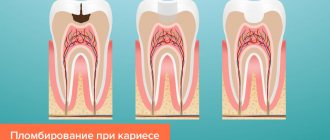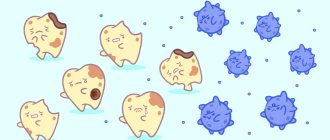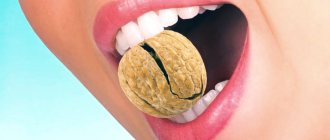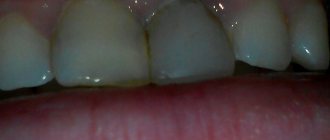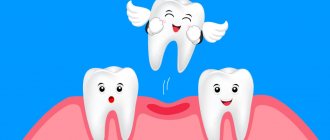Tooth enamel is the hardest tissue in the human body. Up to 90% of calcium reserves are concentrated here. However, cosmetic dentistry regularly deals with defects in this tissue. The fact is that hardness and ductility are different things. With impressive hardness levels, enamel is a fragile material that easily chips and cracks.
The situation gets worse if the enamel is weak. Temperature changes, chronic diseases, blows - and then the tooth breaks off. The situation is unpleasant, and in the long term it is also fraught with caries. Through the crack, bacteria penetrate directly into the tooth, to the pulp, which means that caries will quickly develop into pulpitis. In general, a chipped tooth is a reason to see a doctor, and quickly.
So, what to do if a tooth chips?
- Rinse your mouth with any suitable antiseptic or water to protect the tooth from bacteria and food debris.
- If there is bleeding, apply a tampon with hydrogen peroxide or a hemostatic sponge.
- Apply cold externally to prevent swelling from developing.
- If the pain is very severe, take a pain reliever.
- If a tooth chips on the street, try to rinse your mouth with drinking water (mineral water is also suitable, but not sugary drinks). Other measures can be postponed to your home or the nearest pharmacy.
After that, call your dentist. There is no point in going to emergency rooms - they will simply pull out the affected tooth, especially if a child’s baby tooth has chipped off. You need to eliminate the defect without unnecessary sacrifices.
Fortunately, there are ways to quickly restore a tooth, even if it is severely damaged. There is a whole direction - aesthetic restoration of teeth, it deals with both acquired and congenital defects. Today, restorative dentists work wonders to transform small and uneven teeth into a Hollywood smile. This direction is developed both in pediatric and adult dentistry.
Types of chipped teeth
Restoration methods depend on the damage. Dentists distinguish the following types of chipped teeth:
- Incomplete. A barely noticeable crack appears on the enamel, and the rest of the tooth is not affected. The easiest case, which requires purely aesthetic restoration.
- Enamel chip. If a small piece breaks off from a tooth, most likely only the enamel is damaged. If measures are taken quickly, the deep layers of the tooth will not have time to collapse either.
- Dentin chipping. This layer is located under the enamel, inferior to it in hardness, but reliably protects the nerve and pulp. If dentin is damaged, the tooth usually does not hurt; at most, it reacts to acids and cold.
- Chip exposing the pulp. If a tooth is severely cracked, its darker part is visible, and the person is in pain, this means that the pulp, the most sensitive part of the tooth, is damaged. This is where the nerve and blood vessels are located, so bleeding is common. If the pulp is chipped, you need to make an appointment with a doctor as soon as possible. However, when half a tooth chips off, people usually do not postpone the visit.
Treatment methods - what can be done in dentistry
Now let’s move on to the question of what to do if a child’s piece of a baby tooth breaks off. If this is a one-year-old baby, seek help from a specialist as soon as possible. The doctor will assess the severity of the injury and suggest the best solution to the problem. You may need to undergo x-ray diagnostics and additional examinations. At this stage of development of the body, it is important to make sure that the baby does not have systemic disorders that could lead to a deterioration in the condition of hard tissues and their destruction.
“Many thanks to the doctors of your clinic! My daughter is 4 and a half, she damaged her tooth while playing with other children. Your crown was completely restored for us, very quickly, efficiently and completely without stress for the child. Now she always goes to the dentist in a great mood! Everything is very professional and kind. Thank you for such a correct approach to working with children!”
Valentina V.D., fragment of a review on the website of one of the Moscow dental clinics
If we talk about older children, then if chips of enamel or dentin appear, the dentist can perform a composite build-up to hide the defect. If the cause was caries, the doctor will remove the affected tissue and put a filling. A restoration insert may be required to hide large chips. It looks like a large filling, but it is created from impressions in a separate laboratory. In order to strengthen and saturate the enamel with useful microelements, a course of fluoridation and remineralization is prescribed.
For minor defects, dental treatment is performed
It’s another matter when the pulp or root is damaged during an injury. In the first case, the nerve is removed and the tooth is then restored using a pin. If the root is severely damaged, the tooth is completely removed. And if you wait even more than a year before changing the primary bite, the doctor is obliged to offer temporary prosthetics for this period. Otherwise, even one primary incisor or molar, removed ahead of schedule, can lead to displacement of the rows and curvature of the bite1.
The photo shows teeth after prosthetics
What to do if your front tooth chips
Dental defects are always unpleasant, but it’s especially annoying if they are visible. Dentists call visible teeth the “smile zone” and pay special attention to its condition. So, what to do if your front tooth chips? The doctor will suggest the following restoration methods:
- Surface enamel cracks are simply sanded down. You can also saturate the tissue with minerals to speed up recovery. The problem is solved in one visit.
- If the tooth is cracked down to the dentin, grinding is not enough. The crack can be repaired with special materials that resemble a filling. The color is selected to match the enamel. The material is applied layer by layer, illuminated with a special lamp and finally sanded to perfect smoothness.
- If half a tooth is chipped off, it can be restored with a filling or dentures. Are used:
- veneers - decorative overlays on the tooth surface;
- inlays are metal-ceramic structures that replace part of a tooth;
- Crowns are structures that replace the entire visible part of a tooth.
Aesthetic dentistry tries to preserve the surviving tissue as much as possible, since the choice of methods and materials is very wide. But when a tooth is almost completely destroyed, it may be easier to remove it and install a crown or implant.
What to do if a tooth is broken?
Causes of chipped teeth
There are many reasons for tooth damage, but there is only one way to solve this dental problem - prompt assistance from a specialist who will restore the integrity of the tooth, and at the same time, the aesthetics of the smile and chewing activity.
Among the popular reasons why a tooth chipped are:
- Eating hard and sticky foods
- Mechanical damage (fall, shock)
- Lack of calcium in the body
- Advanced or untreated caries
- Incorrectly installed or old filling
- Crack in enamel
- Malocclusions
Types of dental damage
Chips differ in the degree of damage. But all of them, if contacted in a timely manner, are subject to aesthetic restoration.
- Chip within the enamel
This is damage to the tooth within the enamel, which does not cause pain. Therefore, rarely does anyone address this problem, especially if the tooth does not fall into the smile zone.
- Chip within dentin
This is damage to the less dense layer under the enamel, in which the tooth reacts to hot and cold, sweet and sour. And if you don’t immediately consult a dentist, the remaining dentin will be washed away. Acute pain will begin due to the exposure of the nerve of the tooth.
- Chip to pulp
A deep chip affects the pulp of the tooth, which is accompanied by severe throbbing pain. This is a serious injury that can result in tooth loss if dental care is not provided immediately.
Damage to baby teeth
Has a baby tooth chipped off? Chips on children's teeth occur more often than in adults. This is due to the increased activity of children. Parents incorrectly believe that baby teeth cannot be treated or restored after chipping, since molars will grow over time. After all, healthy first teeth mean strong teeth in adulthood!
What to do if a tooth chips? Disinfect your child's mouth and go to the pediatric dentist. He will apply a special gel that “preserves” the damaged tooth and prescribe treatment. Most often, a baby tooth is restored using a filling.
Dental care for injuries
If a piece of your tooth breaks off, contact your dentist. He will prevent further destruction and restore the tooth with modern materials.
The specialist will suggest the best treatment option depending on the extent of the chip and the location of the tooth.
- Sealing
Tooth restoration using a filling is possible both on the front and chewing teeth in case of minor chips. For this purpose, modern light-curing composite materials are used.
- Veneers
These are ceramic linings on the front surface of the tooth and the cutting edge. Suitable for cases where it is impossible to “build up” a tooth with a filling. Veneers ideally restore the shape of teeth in the smile area.
- Tabs
This is a modern alternative to fillings - ceramic inlays for restoring chewing teeth if they are more than half destroyed. They successfully restore the shape and activity of teeth without wearing off or shrinking.
- Crowns
If a significant piece of the tooth breaks off and damages the pulp chamber, then after removing the nerve and treating the canals, it is necessary to install a crown. If a front tooth has chipped off, aesthetic ceramic restorations are suitable for its restoration, and strong zirconium or metal-ceramic structures are suitable for chewing teeth.
Difficulties and problems with chipping
If you do not pay attention to the fact that a tooth is broken or crumbled, and do not carry out treatment, a number of related problems may arise.
Among them:
- Increased tooth sensitivity
There is a painful reaction to cold and hot food or drinks. Sensitive teeth make it difficult to eat, talk, and even breathe.
- Pulp infection
With an extensive chip, the nerve endings may be exposed. This is already a serious injury with inflammation, when the pulp must be removed.
- Cysts and granulomas
If a large piece of a tooth breaks off, it can provoke the development of complications at the root apex - neoplasms with liquid, most often pus. If left untreated, cysts or granulomas grow in the bone tissue, affecting the stability of the tooth.
Still have questions? Ask them to us
Even if a small piece of a tooth breaks off, it can cause discomfort. If it is on the front tooth, then the aesthetics of the smile is disrupted, which results in awkwardness during communication and changes in facial expressions. If it is on a chewing tooth, it becomes difficult to eat, and food particles can become lodged in the resulting lesions and cause caries. So don’t put off your visit to the dentist! And then he will preserve your natural tooth and restore its original integrity.
If you have any questions, write to us. We will definitely respond to you within one day.
Bochkov Anatoly Evgenievich
Orthopedic dentist
Baby tooth chipped off
Everyone knows that chipped permanent teeth need to be repaired as soon as possible. However, pediatric dentistry often deals with damage to primary teeth. Children who experience the world by taste are especially often affected: it is enough to pull a stone, a plastic toy into their mouth, or simply fall, and the enamel may not withstand it.
First aid for a child whose tooth has chipped is the same as for an adult:
- Calm down, console.
- Give water to rinse your mouth.
- If necessary, stop the bleeding with peroxide or a sponge.
- Apply cold to reduce swelling.
- If the baby complains of pain, give the usual painkiller.
- Call pediatric dentistry in Krasnoyarsk, explain the situation and make an appointment.
The child will be examined by a doctor and sent for an x-ray to find out whether the soft tissues of the tooth have been damaged. The easiest case is if there is a chip on a tooth that was loose even before the injury. In this case, it is simply removed. But if the tooth holds tightly, treatment is needed. Otherwise, bacteria will penetrate through the crack, and this not only threatens the destruction of the baby tooth, but can also lead to problems with permanent ones.
At Mira Dentistry, we know how to find an approach to children whose baby teeth have broken off, even very young ones. After all, choosing a treatment is not difficult; it is more difficult to get a frightened child to trust the doctor. Correction methods are generally the same as for adults: polishing, remineralization, restoration with a filling.
If a child has a broken front baby tooth
First, it is important to understand how serious the injury is. If the front baby tooth is broken at the root, then most likely the dentist will recommend removing it. If only a piece of a tooth breaks off, then tooth extraction can be avoided and restored with aesthetic restoration. A pediatric dentist can use composite materials to build up the missing part of a tooth. Do not rush to remove a child’s baby tooth; the resulting empty socket can subsequently affect the correct formation and development of the permanent bite.
With severe trauma, the tooth may go deep into the gum, and initially it may seem that the child has broken the tooth at the very root. Therefore, it is very important to contact your pediatric dentist immediately.
If the injury was lateral or vertical, then not just tooth dislocation, but displacement of the tooth may occur. If possible, try to preserve the broken piece of tooth by placing it in warm milk or wrapping it in a napkin. Be sure to take it with you to the pediatric dentist.
Make an appointment
Prevention of chipped teeth
The golden rule of medicine: prevention is easier than cure. Prevention of chipped teeth requires:
- Avoid mechanical damage. Those at risk include fans of seeds and hard nuts, as well as those who like to chew pens and pencils.
- Avoid temperature changes in food. Ice cream with coffee is delicious, but if you regularly treat yourself to a combination of hot and cold, you can end up with microcracks in your enamel and an unscheduled visit to the dentist.
- Teenagers and adults: use protective mouthguards when playing traumatic sports. We are talking about boxing and other types of wrestling, hockey, rugby, handball - all where there is a high risk of getting hit in the face and, consequently, a chipped tooth.
- Eat properly. Lack of calcium is the most obvious cause of weakened enamel.
- Monitor the health. Many chronic diseases affect the condition of teeth. With diabetes, gastrointestinal disorders, and endocrine problems, the risk of getting a chipped tooth increases.
And, of course, it is worth monitoring your oral hygiene and regularly visiting adult or pediatric dentistry in order to notice and treat problems with enamel in time.
Why is enamel damaged in children?
Tooth enamel in children can begin to deteriorate for dozens of reasons, the most common of which are:
- Metabolic disorders in the body, as a result of which the teeth do not receive proper nutrition;
- Disorders in the pretanal period, as well as at the age of six months to one and a half years, when all systems in the body are formed.
- Complications during pregnancy - Rh conflict between mother and fetus, severe toxicosis.
- Diseases suffered during pregnancy - rubella, toxoplasmosis, endocrine disorders, influenza, HIV, syphilis, taking hormonal or antibacterial drugs by the expectant mother.
- Chronic childhood diseases - infections, diseases of the digestive system, brain dysfunction, various types of dystrophy.
- Lack of fluoride and calcium in the body.
- Consuming large amounts of sweets, sodas, and sour foods.
- Lack of or negligent attitude towards personal hygiene, bad habits - biting nails, pencils and pens.
- Bruxism (constant rubbing of teeth against each other).
What to do if the enamel begins to peel off?
If you notice that the top layer of your child’s teeth has become thinner, or the baby begins to complain of increased sensitivity of the crowns, you should contact your dentist as soon as possible. The doctor will determine the degree of enamel destruction and prescribe appropriate treatment.
At the initial stage of damage to dental enamel in children, the doctor may prescribe remineralization of the enamel - its saturation with minerals, calcium and fluoride. Using this method, you can strengthen your baby’s teeth in 5-20 days.
If noticeable stains appear on the baby’s tooth enamel, the dentist can perform a filling using special composite materials or install veneers and lumineers to hide the problem.
Prevention of enamel damage
As you know, the best treatment is prevention. To ensure that your child does not suffer from damaged enamel and all the symptoms arising from the pathology, from his very tender age it is worth thinking about strengthening the enamel.
- Balance your diet.
The child must receive all the necessary vitamins and microelements. When breastfeeding, it is also important to plan the nursing mother's menu. The healthiest foods for teeth are dairy and fermented milk dishes, as well as fruits and vegetables. - Treat all diseases on time.
Remember, everything in a child’s body is interconnected, so all acute and chronic diseases must be eliminated in a timely manner. - Teach your child to take care of himself.
Good oral hygiene will help prevent dental problems. Teach your child to brush their teeth twice a day, floss, and rinse their mouth after meals. An excellent means of protection for fragile children's enamel is ASEPTA TEENS toothpaste, created to protect and strengthen the enamel of permanent teeth. The active formula with amino fluoride forms a coating on the enamel of children's teeth, which protects against the negative effects of bacteria and acids and prevents the destruction of enamel. - Keep an eye on your child.
Don't forget, one of the key reasons for the destruction and thinning of children's enamel is mechanical trauma. Keep an eye on your beloved baby and you will minimize the risk of damage.
How much does it cost to fix a chipped tooth?
It happens that people do not seek help because they think that dental restoration is very expensive. In fact, it is easier and cheaper to immediately “fix” a chipped tooth than to wait for bacteria to penetrate through the crack and have to treat pulpitis. Moreover, all our services are available in installments.
In Mira clinics, prices for correction of a chipped tooth start at 2,000 rubles. — this is how much it costs to restore the edges of the front teeth. The final cost of treatment depends on the volume. You can call the clinic and we will tell you how much it costs to fix a chipped tooth in your case. But it’s better, of course, to make an appointment for an inspection - only after assessing the damage can you give an exact price. “Mira” is your dentistry, Krasnoyarsk is not in vain turning to us!
Tooth fracture without pulp exposure
In dentistry, a fracture is understood as an injury in which the enamel prisms diverge from each other, and part of the dental tissue is lost. In the event of a fracture, the prisms are not only separated, but also parts of them are lost. The fracture can also pass through dentin, but in this case the dental pulp remains intact.
X-ray
When conducting radiographic studies, if a child’s tooth has chipped, it is not difficult to determine serious damage, while it is almost impossible to recognize a crack in the picture.
Treatment and postoperative monitoring
For small chips, grinding down the enamel is possible, but for more extensive damage, a composite tooth restoration may be required.
In cases where the patient was able to save the chipped tooth fragment, it is possible to fix it in place using adhesive bonding techniques. The technology for performing the work is fully consistent with the methods used by dentists when providing services for complete dental restoration with composite materials.
Recent laboratory studies have proven that with the use of modern adhesive materials, it is possible to restore the reliability of the connection of the broken area of the tooth, corresponding to the intact tooth.
To increase the aesthetic appeal of the tooth being restored, it is recommended to first create a bevel of small width from composites around the entire perimeter of the broken area, reaching 1-2 mm depending on the specific situation.
Forecasting
After recovery, the patient is required to visit the dentist 2 and 12 months after the procedure. In cases where tooth sensitivity remains within normal limits, there is no need for further observations. The risks of complications due to the pulp are minimal.

